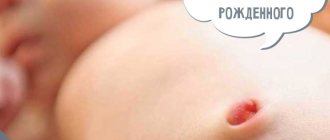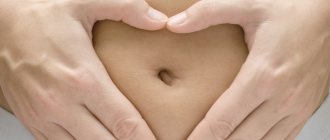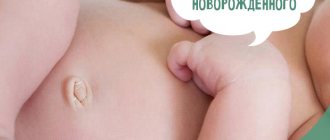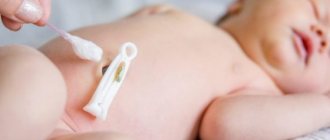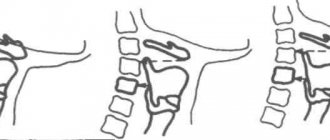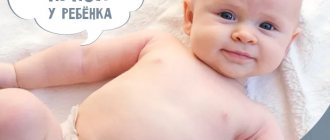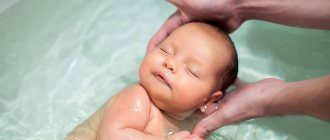The birth of a baby brings great joy and at the same time a lot of troubles to young parents. In the first days after birth, the baby's navel is the most disturbing thing. After all, it is well known that this is the remaining part of the umbilical cord, with which the baby was connected to the mother’s body for nine months. And now this piece has become a wound on the child’s body, and the mother’s task is not to allow it to become infected.
Pediatrician Olga Stepanovich told how to treat a newborn’s navel, what to consider and who to contact.
/
What is an umbilical cord remnant and when does it fall off?
While the baby was in the womb, he received nutrients and oxygen through the umbilical cord. When the baby is born, the umbilical cord is clamped and cut. It is not painful because there are no nerve endings in the umbilical cord.
The clip (or "clothespin") usually remains for one to two days. It can be removed as soon as the remaining umbilical cord dries and stops bleeding.
After the clamp is removed, there will be a remnant of the umbilical cord on the baby's belly, which will gradually dry out, harden and turn from yellow to brown-black.
The remaining umbilical cord usually falls off on its own within a few weeks of the baby's birth. If this does not happen within three weeks of birth, contact your pediatrician.
In some cases, there is a reason why the umbilical cord remnant does not fall off, such as an infection or an immune system disorder. A doctor can determine the exact cause.
When the residue falls off, a wound forms. It may become slightly wet due to the fluids released. Keep your newborn's belly button dry and clean and it will heal completely in no time. If the umbilical cord has not healed within two weeks after the remainder of the belly button falls off, contact your pediatrician.
What does the umbilical wound look like after it falls off?
If there are no complications, the clothespin falls off unnoticeably. So, after undressing a newborn, you will see a fallen clamp with a dried umbilical cord and an umbilical wound. If the process is prolonged, spotting may appear during the fall, and even bleeding may begin.
What does the navel look like after the clothespin falls off?
First aid for bleeding:
- calm down, don't panic;
- apply pressure to the area from which blood is oozing with a sterile cotton swab and hold for 5-7 minutes;
- apply a tight bandage using sterile napkins folded in several layers and a sterile bandage. Do not tighten too much so as not to injure the skin;
- After 30 minutes, remove the bandage.
If the wound stops bleeding, there is no need to run to the clinic.
When a sterile bandage is not at hand, iron with an iron set to maximum temperature, clean gauze or a regular bandage.
How to care for the remaining umbilical cord and umbilical wound
The main thing is to keep the navel area dry and clean. Clean the belly button when changing a diaper or bathing your baby.
Here are some tips worth heeding:
- Keep the remaining umbilical cord dry and clean. Now experts recommend the “dry method” - the remainder of the umbilical cord is in contact with air, it should not be wetted or ointments should be used. You may have heard of a treatment option where the remainder of the umbilical cord is wiped with alcohol, but with the modern approach, the best way is to wait until the remainder falls off naturally. If you have questions, consult your pediatrician.
- Avoid irritation. Try to make sure that the diaper does not come into contact with the remaining umbilical cord. You can fold the diaper waistband or use a disposable diaper with a navel cutout, such as Pampers Premium Care.
- Watch for signs of infection. Transparent discharge, drops of blood and crusts during the healing process of the navel are not a cause for concern. But if you notice any signs of inflammation or your child has a fever, contact your doctor.
- Don't try to tear off the rest. The umbilical remnant should fall off on its own. Don't try to tear it off, be patient.
- Watch for signs of bleeding. When the umbilical stump falls off, you may notice a few drops of blood, and this is completely normal. If there is more blood, contact your pediatrician.
- Do not place a coin on your belly button or cover it with a band-aid. You may come across the opposite advice for preventing an umbilical hernia, but you don’t need to follow it - it can harm the child. If you are concerned about the shape of your belly button or suspect that your baby has an umbilical hernia, consult your pediatrician.
Treatment of the remaining umbilical cord
Natural drying and falling off of the umbilical cord is a painless process for the baby, but you should not try to speed it up by removing it yourself. This can lead to bleeding, inflammation, pain and discomfort for the baby.
To care for the umbilical cord, it is necessary to use antiseptics. A common treatment option is using brilliant green (antiseptic Diamond Green) and a 3% hydrogen peroxide solution. First of all, the place of attachment of the umbilical cord is treated with hydrogen peroxide, and then the place of attachment of the umbilical cord and the umbilical cord itself are treated with brilliant green. This type of care helps the residue dry out and prevents inflammation. After consulting with a doctor, you can choose other modern antiseptics that do not stain the skin to care for your navel.
In some cases, the remaining umbilical cord is removed surgically in the maternity hospital. After cutting it off, bandages are applied to the navel, and doctors carry out observation and treatment.
Bathing the baby during the healing period of the navel
Until the rest of the umbilical cord falls off and the wound heals, it is better not to bathe the baby, but to wipe him with a damp sponge or cloth two to three times a week. At the same time, you can cleanse the navel area.
To wash your baby this way, you will need:
- bowl of warm water
- cloth napkin or small towel
- baby soap
- cotton ball moistened with water
- towel
- clean diaper
- change of clothes
Place your baby on a soft, flat surface: a mattress on a changing table or a towel spread on the floor. All items on the list should be at your fingertips. Never leave your baby unattended during water procedures if he is on a high surface - for example, on a changing table. Fasten it with a seat belt and additionally hold it with one hand.
Wrap your baby in a towel, exposing only those parts of the body that you are wiping. This will keep him warm and comfortable. Wipe your face first, without using soap to avoid getting it in your eyes. Then add soap to a bowl of water and begin to wipe the rest of the body, paying attention to the folds on the neck, behind the ears, and in the genital area.
When treating your newborn's belly button, follow the tips listed above. The area around the navel can be wiped with a cotton ball soaked in water, but do not wet the remainder of the umbilical cord itself.
As soon as the remainder of the umbilical cord falls off, you can bathe the baby in the children's bathtub or sink.
Navel treatment in the maternity hospital
While the baby and mother are in the delivery room, the remainder of the umbilical cord is further processed.
As a result, only a small section of about 2 cm long remains from the umbilical cord. A plastic or, less commonly, metal clamp is placed on the remainder of the umbilical cord. Some maternity hospitals now use an open method of managing the umbilical cord. This means that a bandage is not applied to it, just every day before the baby and mother are discharged from the maternity hospital, the umbilical cord remnant (and after it falls off, the wound) is treated with antiseptic solutions (usually hydrogen peroxide and potassium permanganate - the so-called “potassium permanganate”) .
Every day, the umbilical cord remnant above the bracket becomes drier, in other words, it mummifies. Daily treatment of the umbilical cord remnant also helps to dry it out. As a result, on the fourth or fifth day, in most babies, the umbilical cord looks like a section of dry, dense, non-living tissue. Soon, along with the clamp, this fabric “falls off.” A wound remains, which is called the umbilical wound. In babies with an initially “thicker” umbilical cord, the remainder of it can dry out for quite a long time, for 6-7 or even more days.
Many maternity hospitals have adopted a different tactic for managing the umbilical cord, when it is usually cut off on the second day with a blade or sterile scissors. With surgical cutting, the healing of the umbilical wound proceeds faster. To prevent bleeding, apply a pressure bandage to the wound, which is usually loosened after 1-2 hours and removed the next day during treatment of the umbilical wound.
Some babies have a so-called “cutaneous” navel. With it, the skin, moving from the anterior abdominal wall, covers the area of the umbilical cord, and the impression of a “long” navel is created. It should be noted that after the umbilical cord falls off or is removed, the tissues of such a navel are retracted and, as a rule, the umbilical area is no different from the usual one.
The umbilical wound gradually heals, becoming covered with a hemorrhagic (dense “bloody”) crust. If the child continues to be in the maternity hospital at this time, then the umbilical wound is treated in the same way as before the umbilical cord remnant - once a day. If the umbilical wound is wide and there is possible light urinary discharge, the doctor may prescribe more frequent treatment. As with any wound, the hemorrhagic crust that forms on the umbilical wound gradually disappears. If healing proceeds well, then after the thick crust falls off there is no discharge from the wound. Sometimes, when a large crust falls off (this happens with a wide umbilical wound), droplets of blood may be released, and the wound “touches up.” Usually in such cases, additional (2-3 times a day) treatment with solutions of hydrogen peroxide and potassium permanganate, and sometimes a special hemostatic (hemostatic) sponge, which in most cases is enough to be applied to the wound once, is sufficient.
Changing diapers while the navel is healing
In our separate article you will learn how to change your baby's diaper. In the first weeks, be especially careful not to touch or wet the remaining umbilical cord when changing your baby's diaper.
If the remaining umbilical cord has not yet fallen off, fold the diaper over your baby's tummy or use diapers with a belly button cutout to prevent friction and urine from getting into the belly button area.
Follow the care instructions described above. We remind you: while changing the diaper, you can also gently wipe the skin around the navel with a cotton ball soaked in water.
Problems with the umbilical cord
Sometimes inflammatory diseases of the umbilical cord are possible. In the absence of normal mummification, shedding does not occur, and the residue remains moist for a long time. This provokes inflammation and gangrene. In mild cases, the baby’s condition is not affected, but if the inflammation worsens, the newborn becomes restless. The mother’s task is to draw the doctor’s attention to possible problems with the navel . Such warning signs may include:
- the umbilical cord remnant does not fall off for a long time
- there was an unpleasant smell
- poor appetite, baby's sleep, general anxiety
- increase in body temperature
You should never hesitate to consult your pediatrician if you have any concerns about your belly button!
Possible problems
When it comes to the belly button and umbilical cord, there are two conditions that occur in babies. Contact your pediatrician if you notice any of these signs in your child:
- Fungus of the navel (granuloma).
After the remaining umbilical cord falls off, you may notice a reddish, moist nodule that may become enlarged and leak a little fluid. In some cases it will disappear in about a week, but if not, contact your pediatrician
- Umbilical hernia.
If your baby's belly button sticks out when he cries, it may be an umbilical hernia. An umbilical hernia is a small hole in the abdominal wall through which tissue protrudes when there is pressure, such as when a baby cries. An umbilical hernia usually heals by the age of –18 months.
When does the clothespin come off?
Each child has its own umbilical cord thickness.
The thinner it is, the faster the death occurs. For some, this happens as early as day 3. If the clothespin falls off after 15–17 days, this is also normal. Signs that parents should be alert to:
- unpleasant odor;
- redness around the navel;
- copious discharge.
With prolonged death or infection, the navel can fester. If you find the listed symptoms, show your baby to a doctor or local nurse.
Umbilical cord tying method
Cutting the umbilical cord with scissors occurs after fixation with threads or a clothespin.
Against the background of using a clothespin to form the navel, the ligation method also looks outdated, as it requires a certain skill. In general, these methods are similar, but when bandaging the doctor performs more actions:
- Ligation is carried out when the umbilical cord stops pulsating. It is wrapped with two threads: the first is tied 2 cm above the skin of the abdomen, and the second - 15 cm from the first.
- It is very important to sanitize the scissors when performing circumcision to avoid infection. Immediately after using antiseptic solutions, cut the umbilical cord between the threads closer to the one located above the abdomen.
After this, the umbilical cord is left alone; with proper care, after a while it falls off.
When using a clothespin, the navel is not tied in two places; the area is simply secured with a clip. But this method has one drawback - caring for the wound becomes somewhat more difficult. Parents should understand this point and pay more attention to the untreated area.
How to speed up healing?
For speedy healing it is necessary to provide proper care. How to do it?
- After birth, the umbilical cord section itself is treated first with peroxide and then with potassium permanganate. Maybe iodine. This removes all blood clots and disinfects them. Although it is believed that if the cutting occurs after the pulsation has stopped, infection is unlikely. However, it is necessary to watch and process.
- Until the stump falls off, carry out the treatment once or twice a day. How? Yes, the same peroxide, and antiseptics include brilliant green, potassium permanganate (weak solution), chlorophyllipt, etc.
- Don't wrap up the baby! Provide air access to the umbilical remnant. There is an opinion that only air can heal a wound. No more processing. I do not share this position. I think that in such a case you need to insure yourself. After all, if anything happens, there is no one to blame except the parent. So disinfect, but don’t forget about air baths.
- Don't rub the umbilical cord. Use diapers with a special cutout. Or roll up the edges.
- Bathe (if you dare to do so) the first days after discharge only in boiled water.
As you can see, the main rule is careful attitude. The main thing is not to overdo it. After all, everything is good in moderation!
Tell us, how did your baby’s umbilical cord get cut? Or are you just studying this issue? If so, what are you leaning towards? Leave comments and become blog subscribers. Bye. See you again!
How long does it take for a belly button to heal?
While still in the maternity hospital, the baby's umbilical cord is cut off and a clamp is left at the cutting site to prevent bleeding. The clothespin is removed after 3-7 days, and in its place the baby is left with an umbilical wound. It should be treated with antiseptic agents for at least two weeks, protected from infection, and periodically ventilated.
The navel heals during the first month of life; this process can be divided into several stages:
- first . Lasts about 3-5 days. The navel looks like a knot;
- second . Occurs approximately 6-8 days after birth. The umbilical cord dries out and falls off;
- third . This is 1-3 weeks after birth. The navel looks like a deep wound. There may be ichor coming out of it. Periodic discharge of drops of blood from the umbilical wound is also acceptable;
- fourth . This is 3-4 weeks after birth. The navel is completely tightened.
The speed of healing of the umbilical wound is individual for each child.
The duration of the healing process is influenced by the following factors:
- characteristics of the baby’s body, the speed of regenerative processes;
- proper care of the umbilical wound;
- the strength of the baby's immune system.
Incorrectly tied navel
Umbilical hernia
Some parents believe that an improperly tied belly button protrudes outward over time. But in reality there is no such term as abnormal umbilical cord formation. Protrusion is associated only with an umbilical hernia, which either goes away on its own by 3-5 years or requires medical treatment.
In any case, if you suspect the development of pathologies in the umbilical ring area, you should consult a doctor. The baby will be tested, palpated, and given an ultrasound to determine the condition of the inner wall of the peritoneum and cavity.
It happens that a bulging navel lasts for life. This also cannot be considered an indicator of pathology, only a cosmetic defect. You can get rid of it using plastic surgery methods and nothing else.
In maternity hospitals, several methods of tying the umbilical cord in newborns are used. However, they cannot influence the final shape of the navel. If an adult or child's belly button is constantly protruding, you first need to make sure that it is not a hernia.
Caring for the umbilical wound
The umbilical wound remains after the umbilical cord has fallen off. The average healing time is 4-10 days. It is at this time that it is necessary to monitor the epithelization process and organize proper care to reduce the risk of an inflammatory process. Previously, it was practiced to treat the umbilical wound daily with 3% hydrogen peroxide and brilliant green (or other antiseptics without coloring properties) until it is completely healed. Currently, many medical specialists have abandoned this practice, which has caused many questions and disputes among mothers. Antiseptics can be used in the toilet of the umbilical wound as an additional measure to dry it out. If dirt does not get into the umbilical wound and it rarely comes into contact with water, then healing can proceed normally without special treatment. Excessive use of medications, constant trauma to the wound with hands, cotton swabs and cotton pads can cause inflammation. Therefore, moderation is important everywhere! If you decide to refuse daily special treatment, then do not forget to regularly examine your navel. If daily toileting of the navel is practiced, then the treatment is carried out once a day, and all manipulations must be careful. Until the umbilical wound heals, the baby is not allowed to bathe in a shared bath. Rubbing and washing are not prohibited, but the navel area should not be washed or rubbed excessively.
Can a belly button come undone?
So is it true that even an adult’s belly button can come undone from a strong scream? Not really. The child has this risk while the thread is still attached. For an adult, there is nothing to untie there. The scars don't unravel.
What does an untied belly button pose to a baby? Bleeding. Therefore, if you choose this method, you need to be confident in the professionalism of the doctor. As a rule, a sea knot is made with a strong silk thread. And the stump falls off after a few days. The same as with a clothespin. And, of course, the speed of healing will depend on the efforts of the mother herself.
Umbilical cord formation methods
Using a clothespin to prevent blood flow
In the maternity hospital, a newborn’s navel is tied in one of three ways:
- cutting off the umbilical cord with a blade followed by healing of the umbilical wound;
- using a clothespin to prevent blood supply to the appendix;
- tying a knot.
Surgical excision of the appendix is practiced extremely rarely, which is associated with possible consequences. There are doctors who are confident that surgical excision leads to better healing, but other doctors do not agree with this opinion.
The method of shaping the navel does not in any way affect the resulting shape in the future. However, surgical excision is practiced less and less, as it is associated with high morbidity and risk of infection.
